John Thirtle
John Thirtle (22 June 1777 – 30 September 1839) was an English watercolour artist. Born in Norwich, where he lived for most of his life, he was a leading member of the Norwich School of painters, whose paintings of the city are considered to be outstanding in the history of watercolour painting.
John Thirtle | |
|---|---|
.jpg.webp) A lithograph by Charles John Watson (from a self-portrait by Thirtle, painted in 1816)[1] | |
| Born | 22 June 1777 Norwich, England |
| Died | 30 September 1839 (aged 62) Norwich |
| Resting place | Rosary Cemetery, Norwich 52.62747°N 1.31470°E |
| Nationality | British |
| Education | Apprenticeships in Norwich and London |
| Known for | Watercolour landscape painting, frame-making |
| Movement | Norwich School of painters |
| Spouse(s) | Elizabeth Miles |
Much of Thirtle's life was never documented, and only an outline of his business activities, family life and his place as an artist in Norwich is known. He was apprenticed to a London frame maker before returning home to Norwich. There he set up a successful frame-making business, whilst continuing to paint as well as working as a drawing-master, a printseller and a looking glass maker. In 1812 he married Elizabeth Miles, the sister-in-law of the artist John Sell Cotman. He suffered from tuberculosis for much of his life, and his worsening health reduced his artistic output up to his death in 1839. He produced relatively few works: his unpublished manuscript Treatise on Watercolour was probably for his own use, and he exhibited fewer than a 100 paintings. He was a member of the Norwich Society of Artists and for a time its vice-president, but in 1816 he was one of a number of artists who seceded from the Society to form a separate association, which dissolved after only three years.
The majority of Thirtle's watercolours are of Norwich and the surrounding Norfolk countryside, many being riverside scenes. His style, which was influenced by Thomas Girtin, Crome and (to a lesser extent) John Sell Cotman, was both technically accomplished and individual. His earlier landscapes were painted with a restricted range of buffs, blues and grey-browns, but he later developed a brilliancy of colour, producing works that included angular block forms. Unhappily, the quality of several of his watercolours has deteriorated, due to the fading of a particular indigo pigment that he used extensively and to great effect.
Life
Family, early life and apprenticeship
.jpg.webp)
The surname Thirtle (sometimes spelt Thurtle or Thurtell)[2] is a form of Turkle, from Thor-ketil, the sacrificial cauldron for the god Thor.[3] John Thirtle.was the son of John Thirtle and his wife Susanna Lincoln (who married in 1776).[4] He was probably born in a house close to St Saviour's Church, Norwich, and was baptised at the church on 22nd June 1777.[5] A sister, Rachel, was baptised on 13 August 1780 and an older brother named James was baptised in 1785.[6] His parents were well-known members of the local community. His father, a bootmaker, worked in Elephant Yard, off Magdalen Street, and was an overseer of the poor as well as a churchwarden at St. Saviour's. Nothing is known of Thirtle's early boyhood or education.[7]
In 1790, the 13-year-old John was apprenticed to Benjamin Jagger of Norwich, the leading carver and gilder, picture dealer and printmaker in the city.[8][9][10] In about 1799 Thirtle moved to London to serve another apprenticeship, possibly under a Mr. Allwood,[7] again learning to make picture frames.[11] During his years as an apprentice in London he studied the works of John Sell Cotman at Rudulph Ackerman's print shop at 96, The Strand,[12] after Cotman had moved to the capital in about 1798.[13]
Frame-making business
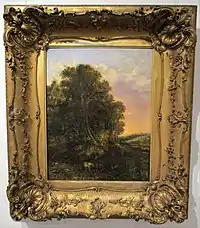
On successfully completing his years as an apprentice, Thirtle returned to Norwich and set himself up to produce picture frames and prints in a shop in Magdalen Street. During what appears to have been a mainly uneventful life, he rarely left his home city again.[11] He is recorded as having returned in 1805, when he exhibited five paintings at an exhibition of the Norwich Society of Artists. In 1806, when he had already established himself as a picture framer and gilder in Norwich, he described himself in the Society's catalogue as a "Miniature Painter and Drawing Master". His extensive business activities, and particularly the production of his decorative picture frames,[14] led to his becoming one of the more financially successful members of the Norwich School, despite strong competition from Jeremiah and William Freeman, who dominated the Norwich framing market during this period.[15][16]
Several of Thirtle's own frames have survived and point to his fine craftmanship.[17] Many paintings by fellow members of the Norwich School were framed by Thirtle's business and bear his name on the frame, including those by John Sell Cotman, John Crome, Thomas Lound, James Sillett and Joseph Stannard.[15] At least one such framed painting, Vincent's Trowse Meadows, near Norwich, an oil on canvas that was first exhibited in 1828, was copied by Thirtle, who produced the same scene as a watercolour.[18] His trade label took several forms, ranging from the early "Thirtle, Miniature Painter, & Drawing Master" to the elaborate "Carver, Gilder, Picture Frame and Looking Glass Manufacturer, Wholesale and Retail", used in the 1830s.[8]
Paintings still in Thirtle's original frames can be dated as being before 1837, the year John Thirtle died. William Boswell, who took over the business that year, initially included "Late Thirtle" in brackets on his labels.[19] In 1922, W. Boswell & Son acknowledged in one of their publications that "Thirtle was a well-known frame maker, and the maker of the now famous swept frame, which has never been equalled, he also was, and still is an artist of no small repute".[20]
Artistic career
Thirtle's earliest known work was The Windmill. This landscape painting seems to have been unusual, as many of his early works were portraits and paintings of other subjects, but by then he had begun to increase his output of landscapes, and to stand out as a master of the genre of watercolour painting.[13] Painted in 1800, The Windmill was catalogued by the Norwich Art Circle in 1886. In 1803 John Crome and Robert Ladbrooke formed the Norwich Society of Artists, a group that also included George Vincent, Charles Hodgson, Daniel Coppin, James Stark and Robert Dixon. Their first exhibition, in 1805, marked the start of the Norwich School of painters, the first British art movement to be created outside London.[21] In the exhibition Thirtle showed five paintings out of the 71 exhibited by five artists: Crome, Ladbrooke, Hodgson, Dixon and Thirtle himself.[22]
He was probably a founder member of the Norwich School of Artists, but his membership of the Society was only first recorded three years after it was founded. His exhibited miniatures during the first years of the Society, but afterwards developed to become a landscape artist, notably of scenes of the rivers Yare and Wensum, and of thunderstorms.[23] He served as Vice-President of the Society from 1806 to 1812. His output of exhibited works declined from a peak of 17 (in 1806) until he exhibited only six works in 1817, and none the year after that, making a total of 97.[6] He exhibited only once outside Norwich, at the Royal Academy in 1808.[24]
Marriage
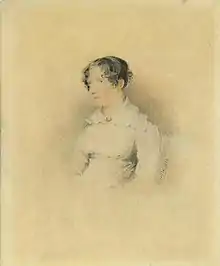
On 26 October 1812 he married Elizabeth Miles of Felbrigg,[25] whose father was "of some means",[6] and whose sister Ann had married John Sell Cotman three years previously. John and Elizabeth were married at St. Saviour's, the church in Norwich where he had been baptised 35 years previously. The marriage produced a close association with Cotman that influenced Thirtle's artistic style.[23] The two artists probably worked together when Cotman was producing drawings of the interior of Norwich Cathedral in around 1808, as similar drawings by Thirtle from this time have survived.[26] The two Miles sisters were themselves amateur painters, having shown their work at the Norwich Society of Artists exhibition of 1811.[27][15] There were probably no children produced from the marriage.[6]
Secession from the Norwich Society of Artists
In 1814 Thirtle was elected President of the Society, but he was one of three leading artists to secede from the Society in 1816, to form the Norfolk and Norwich Society of Artists.[6] The secession was caused by a disagreement over how the profits of the exhibitions should be used, and led to Robert Ladbrooke, James Sillett, Joseph Clover, Joseph Stannard and John Thirtle renting part of the Shakespeare Tavern on Theatre Plain and holding their own exhibition, The Twelfth Exhibition of the Norfolk and Norwich Society of Artists, to rival the original Society's exhibition in Sir Benjamin's Wrench's Court.[28]
Thirtle's decline in output from 1806 was reported by the local press, whose disappointment was expressed in 1811: "We lament exceedingly that Mr. Thirtle, who made up the seceding triumvirate, should not have found time for a single drawing. His occupation is doubly to be regretted, because he stands highest and alone in the particular and beautiful department of watercolours in which he has evinced so much decided excellence". Although Thirtle continued to work, he exhibited nothing from 1818 to 1828.[15]
At some time, whilst John Sell Cotman was contributing drawings for the Excursions in the County of Norfolk (1818), Thirtle went to Great Yarmouth to help his brother-in-law, but none of his drawings appeared in the published work, and he probably assisted Cotman by relieving him of his teaching activities.[29]
Later life
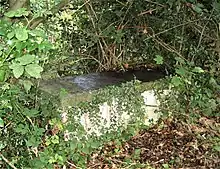
It is known that by 1824 Thirtle was taking on pupils: he was employed by Thomas Blofield to instruct his daughter Mary Catherine and he also taught James Pattison Cockburn.[15] Thirtle's mother died in 1823: an inheritance from his father, who died in 1825, may have given him some financial security for the remainder of his life, as 1825 is the first year in which he is known to have independently owned property.[6]
After the dissolution of the Norwich Society of Artists in 1833, its main artists, including Thirtle, continued to be active. He continued to produce picture frames as well as to paint river scenes, reminiscent of the works of Peter De Wint (1774-1849).[30]
He is known to have suffered from tuberculosis, then known as consumption, for many years. This greatly interfered with his work output, although Clifford has commented on the stronger and more freely expressed manner of these later drawings.[23] Thirtle died of tuberculosis in Norwich on 30 September 1839, and was buried in the Rosary Cemetery in Norwich.[31] The tomb-chest of John Thirtle and his wife can be found in Section E (Reference E759 Sq(uare)).[31] After his death, the framing business was taken over by William Boswell. In Thirtle's short will, made in 1838 and proved in December 1839, he described himself as both a carver and a gilder.[8] He left the sum of £2000 to his wife Elizabeth, a considerable sum of money in those days. She outlived him by many years, dying in 1882 at the age of ninety-five.[6]
Technique
John Thirtle exhibited a total of ninety-seven works in Norwich, and only a handful of his landscapes were not either of the city itself or of the Norfolk countryside.[15] His style was influenced by Thomas Girtin (1775-1802) as well as fellow members of the Norwich School, such as John Crome and John Sell Cotman.[32] Thirtle responded to the genius of Cotman, who was his brother-in-law, by producing works that were both technically accomplished and individual.[33] The artist Henry Ladbrooke, who was a contemporary of Thirtle's, wrote: "As a man of genius, Cotman was much Crome's superior and, as a colourist, Thirtle far surpassed them both".[11] His watercolours can easily be distinguished from those of Cotman and only occasionally show his influence, as with his watercolour Old Waterside Cottage, Norwich. Thirtle typically did not use the kind of flat washes that Cotman used regularly.[34]
No letters to or from John Thirtle seem to have been preserved.[2] He wrote a Manuscript Treatise on Watercolour, written no earlier than 1810, which is now in the Norwich Castle Museum, but nothing else written by him has survived. The treatise was more a reference manual for his own use than a means of perpetuating his ideas for the future.[6]
Although he attempted to paint in oils, he is known for his watercolours. The Times, announcing an exhibition of Thirtle and other lesser known members of the Norwich School in July 1886, described him as "a good portrait painter and a charming landscapist in watercolour, his drawings being full of observation and treated with a freedom, breadth and delicacy that are really remarkable".[35] His earlier landscapes, from 1808 to 1813, were painted mainly with a restricted range of buffs, blues and grey-browns, as exemplified by Interior of Binham Abbey (1808), now in the Ashmolean Museum, Oxford.[36] With later paintings (during the period 1814-19) he reached his peak, and according to the art historian Margarie Allthorpe-Guyton, his scenes were painted with "limpid, silvery tonality and broad assured washes".[32] We went on to paint with greater brilliancy of colour, producing works that included angular block forms.[32] The writer Derek Clifford compared John Crome with Thirtle, describing him as less able to "give the impression of an unaffected, unselected chunck of nature" than Crome, whilst still managing to organise his subjects harmoniously, without them being self-conscious or forced.[13] His pictures of riverside landscapes of Norfolk have a trait that was peculiar to his style - a boat gliding along on the water from the left.[32]
Use of indigo
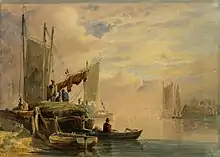
Thirtle used an indigo pigment for producing fine greys. Those watercolours where the pigment was used have deteriorated because the pigment fades to red when exposed to light. This unfortunate reddening characteristic of his paintings cannot be applied to them all, but it is sometimes assumed that Thirtle's works are all permanently ruined in this way. Equally, the use of indigo by other painters has meant that their works were in the past sometimes incorrectly attributed to John Thirtle.[37]
An example of such a work is his River Scene with laden Wherries and Figures, an undated pencil and watercolour, in which the pink glow of the sky and the sea have been unintentionally caused by the fading away of the original greyish blue colours. The original colours produced by Thirtle can still be seen around the edges of the painting, where there was much less exposure to light.[38]
Legacy
Thirtle's works were collected by Thomas Lound, a prolific water colourist and etcher who was found to have owned seventy of Thirtle's drawings at the time of his own death in 1861. Lound's etching of Devil's Tower - Looking towards Carrow Bridge created a superb rendition in black and white of Thirtle's original watercolour.[39]
The Norwich Art Circle held an exhibition of his paintings in 1886. In 1939, the centenary of his death, an exhibition of his works was held in the Norwich Castle Art Gallery, but it was forced to close prematurely because of the outset of the Second World War.[40][41] A biennial exhibition of Thirtle's works, along with some of those of his contemporaries, was held at Norwich Castle from 18 June to 4 September 1977,[42] with Thirtle's treatise on watercolour painting being published for the first time in the accompanying exhibition catalogue by Marjorie Allthorpe Guyton.[43]
Under the conditions of the Colman Bequest, when in 1946 thousands of works by artists from the Norwich School were donated to the city by the Colman family, works such as those by Thirtle were not expected to be exhibited outside Norwich.[44] Those of Thirtle's drawings and paintings that formed part of the Colman family's collection and which are now kept in Norwich Castle, held in specially built cabinets, are only rarely shown on to the public in Norwich or elsewhere, but many can be viewed online.[1]
Selected paintings
- Portrait of Ann Miles, later Mrs. John Sell Cotman – Norfolk Museums Collections.[45]
- View on the River Wensum, St George’s, Norwich – Norfolk Museums Collections[46]
- View on the River, near the Devil’s Tower – Norfolk Museums Collections[47]
- Part of the Interior of Binham Abbey – Norfolk Museums Collections[48]
- View on the River, from the Arch of Bishop’s Bridge – British Museum[51]
- Sunset Landscape with Thorpe Hospital, Norwich – Norfolk Museums Collections[54]
Gallery
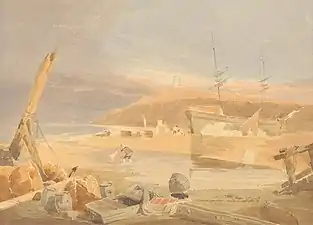 Shore Scene with Sailing Ship at Quay (undated), Yale Center for British Art
Shore Scene with Sailing Ship at Quay (undated), Yale Center for British Art.jpg.webp) Tombland, Norwich (1830), Norfolk Museums Collections
Tombland, Norwich (1830), Norfolk Museums Collections).jpg.webp) Old Lynn (undated), Tate Britain
Old Lynn (undated), Tate Britain View near Bishopsgate Bridge with Cow Tower, looking towards Mousehold (1816), Yale Center for British Art
View near Bishopsgate Bridge with Cow Tower, looking towards Mousehold (1816), Yale Center for British Art The Devil's Tower near King Street Gates - Evening (undated), Norfolk Museums Collections
The Devil's Tower near King Street Gates - Evening (undated), Norfolk Museums Collections
References and notes
- Allthorpe-Guyton 1977, p. 71.
- Allthorpe-Guyton 1977, p. 11.
- Wilson 1995, p. 446.
- John Thirtle and Susanna Lincoln in "Parish registers for St. George Colegate, Norwich, FamilySearch (John Thirtle and Susanna Lincoln).
- John Thirtle in "Archdeacons transcripts for Norwich parishes, 1600-1812", FamilySearch (John Thurtle (sic)).
- Allthorpe-Guyton 1977, pp. 11–17.
- Allthorpe-Guyton 1977, p. 12.
- Simon, Jacob (2012). "John Thirtle, Magdalen St,Norwich by 1808-1839". National Portrait Gallery: British picture framemakers, 1600-1950 - T. National Portrait Gallery. Retrieved 16 July 2018.
- Fawcett 1978, p. 79.
- Benjamin Jagger of London Lane, Norwich, started business carving and gilding picture frames in 1764. By 1773 he was advertising his skills as a drawing master: ...have received Instructions from the most eminent Masters of London in the new and expedious Method of Painting Pictures in Oil… [he] engages to teach Ladies and Gentlemen the Art in a few Lessons, so as any Person may be able to paint History or other Pictures in an elegant and pleasing Manner. (Fawcett, Eighteenth-Century Art in Norwich, pp. 79-80, 85.)
- Walpole 1997, p. 109.
- For more information about Rudolph Ackerman (1764-1834), an early lithographer and colour printer whose shop in the Strand was set up in 1796, see the article by Heatons of Tisbury.
- Clifford 1965, p. 24.
- Scott 1998, p. 96.
- Moore 1985, p. 78.
- "Freeman, Jeremiah and successors, Norwich; carvers and gilders (1792–1850)". British and Irish Furniture Makers Online. University of London; Furniture History Society. Retrieved 15 July 2018.
- Allthorpe-Guyton, John Thirtle, 1777-1839, p. 12. According to Marjorie Allthorpe-Guyton, some early framing moulds by Thirtle have been preserved. They are now in the Bridewell Museum, Norwich.
- Moore 1985, p. 46.
- Scott 1998, p. 98.
- Scott 1998, p. 100.
- Walpole 1997, p. 19.
- Clifford 1965, p. 18.
- Cundall 1920.
- Walpole 1997, p. 27.
- The licence bond for John Thirtle and Elizabeth Miles is now held at the Norfolk Record Office (reference ANW 24/87/48).
- Kitson 1982, p. 108.
- Walpole 1997, p. 110.
- Cundall 1920, p. 28.
- Kitson 1982, p. 185.
- Clifford 1965, pp. 60–61.
- Hamlin 1986, p. 107.
- Allthorpe-Guyton 1977, pp. 20–24.
- Moore 1985, pp. 78–79.
- Clifford 1965, p. 38.
- "The Times". London. 12 July 1886. Retrieved 5 July 2018.
- Dickes 1906, p. 221.
- Clifford 1965, p. 25.
- Allthorpe-Guyton 1977, p. 66.
- Searle 2015, p. 71.
- "Norwich Mercury (3 July 1886, p. 4)". The British Newspaper Archive. The British Library. 2018. Retrieved 2 August 2018.
- "Illustrated London News (29 July 1939, p. 16)". The British Newspaper Archive. The British Library. 2018. Retrieved 2 August 2018.
- Allthorpe-Guyton 1977, p. 7.
- Hemingway 1977.
- "Romantic Landscape: The Norwich School of Painters 1803–1833". Tate. 2000. Retrieved 15 September 2018.
- "Old Master & 19th Century Paintings, Drawings & Watercolours Day". Christie's. 2010. Retrieved 25 September 2018.
- "View on the River Wensum, Norwich (drawing)". Norfolk Museums Collections. Norfolk Museums. Retrieved 25 September 2018.
- "The Devil's Tower (drawing)". Norfolk Museums Collections. Norfolk Museums. Retrieved 25 September 2018.
- "Interior of Binham Priory (drawing)". Norfolk Museums Collections. Norfolk Museums. Retrieved 25 September 2018.
- "Devil's Tower near King Street Gates - Evening (drawing)". Norfolk Museums Collections. Norfolk Museums. Retrieved 25 September 2018.
- This faded watercolour depicts one of Norwich two medieval boom towers across the River Wensum, possibly made in c.1809. Thirtle painted the tower on five different occasions. (Marjorie Allthorpe-Guyton, John Thirtle, 1777-1839, p. 39.)
- "Collection online". The British Museum. 2017. Retrieved 25 September 2018.
- Thirtle was praised by the Norwich Mercury when this painting was exhibited in 1817: "The Scene on the King Street River is a singular and beautiful Drawing, the gleam of light over the meadow beyond the Rainbow, is well executed, and has a very pleasing effect." (Marjorie Allthorpe-Guyton, John Thirtle, 1777-1839, p. 58.)
- "Rainbow Effect on the River, King Street, Norwich (drawing)". Norfolk Museums Collections. Norfolk Museums. 1817. Retrieved 25 September 2018.
- Marjorie Allthorpe-Guyton, in John Thirtle, 1777-1839 (p. 68) notes that "the intensity of colour and assured handling... ...make it one of the most impressive of Thirtle’s late drawings." ("Sunset Landscape with Thorpe Hospital, Norwich (drawing)". Norfolk Museums Collections. Norfolk Museums. 1828. Retrieved 25 September 2018.)
Sources
Books
- Clifford, Derek Plint (1965). Watercolours of the Norwich School. Cory, Adams & Mackay. OCLC 1624701.
- Cundall, Herbert Minton (1920). The Norwich School. London: Geoffrey Holme Ltd. OCLC 472125860.
- Dickes, William Frederick (1906). The Norwich School of Painting: being a full account of the Norwich exhibitions, the lives of the painters, the lists of their respective exhibits, and descriptions of the pictures. London, Norwich: Jarrold & Sons Ltd. OCLC 192940599.
- Fawcett, Trevor (1978). Art and Artists of the Norwich School. The Walpole Society. 46. London: Pitman Press. OCLC 71296442.
- Hamlin, P.E. (1986). Rosary Cemetery: Monumental Inscriptions 1819-1986 & Burials 1821-1837. Norfolk Genealogy. 18. Norwich: Norfolk & Norwich Genealogical Society.
- Hemingway, Andrew (1977). "John Thirtle at Norwich". The Burlington Magazine. 119 (893): 588–591. JSTOR 878848.
- Kitson, Sydney D. (1982). The Life of John Sell Cotman. London: Rodart Reproductions Ltd. ISBN 978-0-9503307-1-6.
- Moore, Andrew W. (1985). The Norwich School of Artists. HMSO/Norwich Museums Service. ISBN 978-0-11-495239-6.
- Searle, Geoffrey R. (2015). Etchings of the Norwich School. Norwich: Lasse Press. ISBN 978-0-9568758-9-1.
- Scott, Peter Kennedy (1998). A Romantic Look at Norwich School Landscapes. Ipswich: Acer Art Publishing. ISBN 978-0-9534711-1-9.
- Walpole, Josephine (1997). Art and Artists of the Norwich School. Woodbridge: Antique Collectors' Club. ISBN 978-0-9559320-4-5.
- Wilson, R.M (1995). A dictionary of English surnames. Oxford, New York: Oxford University Press. p. 446. ISBN 978-0-19-863146-0.
Exhibition catalogues
- Allthorpe-Guyton, Marjorie (1977). John Thirtle, 1777-1839: Drawings in Norwich Castle Museum. London: Norfolk Museums Service. ISBN 978-0-903101-23-3.
- Norfolk and Norwich Art Circle (1886). John Thirtle : Norwich Art Circle: catalogue of the third exhibition, held at the Society's Room, Old Bank of England Chambers, Norwich, July 1886. Norwich.
- Oppé, Adolf Paul (1939). Catalogue of loan exhibition of pictures illustrating the work of John Thirtle of the Norwich school, 1777-1839. Norwich: Norwich Castle Museum.
External links
| Wikimedia Commons has media related to John Thirtle. |
List of works
- 281 works by John Thirtle held in the Norfolk Museums Collections
- 10 works by John Thirtle in the Victoria and Albert Museum
- 13 works by John Thirtle in the Yale Center for British Art, New Haven, Connecticut
- 31 works by John Thirtle at Artnet
- 25 works by John Thirtle (including several prints by Thomas Lound after Thirtle) at the British Museum
- 2 works by John Thirtle in the National Gallery of Canada
- Works by John Thirtle sold at auction according to Invaluable
Other links
- Photographs of the buildings of Magdalen Street, Norwich by the photographer George Plunkett, taken prior to the demolition of much of the area of Norwich where the Thirtle family lived and worked, including Elephant Yard and John Thirtle's house.
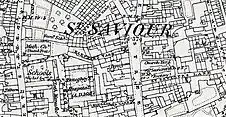
.jpg.webp)